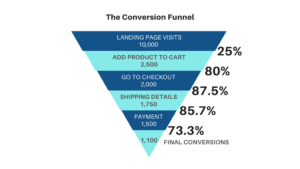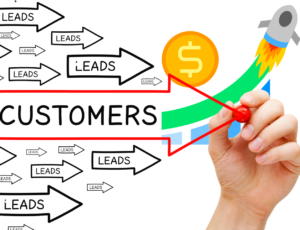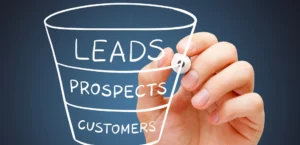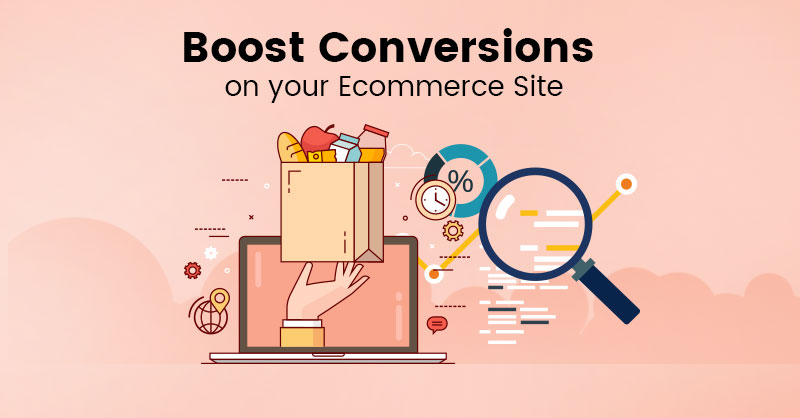In the vast expanse of the digital marketplace, it’s easy to get lost in the sea of online shoppers. You’ve poured your heart and soul into creating a stunning ecommerce website, filled with products that are sure to delight. But, despite the impressive traffic numbers, your sales remain stagnant. The harsh reality is that having a beautiful website and a great product is only half the battle. The real challenge lies in converting curious browsers into loyal buyers. It’s a puzzle that has stumped even the most seasoned ecommerce entrepreneurs. But fear not, we’re about to uncover the secrets to boosting your ecommerce conversions. We’ll dive into the proven strategies that will turn your browsers into buyers, and your online store into a thriving success.
Understanding the conversion funnel: Every click counts

The conversion funnel is a journey that every online shopper takes, from the moment they land on your website to the final click of the “buy now” button. It’s a fragile path, fraught with obstacles and opportunities for abandonment. Every click, every hover, and every scroll is a crucial moment in the buyer’s decision-making process. Understanding the conversion funnel is essential to identifying the pain points and areas of improvement that can make all the difference between a browser and a buyer. Analyzing the funnel, you pinpoint where visitors are dropping off, why they’re not completing their purchases, and what’s preventing them from converting. Is it a clunky checkout process? A lack of trust indicators? A confusing product description?
Strategies to supercharge your conversion rate

The moment of truth has finally arrived – your customers have landed on your website, browsed through your products, and are now just one step away from making a purchase. But, will they actually seal the deal? The answer lies in the subtle yet significant differences between a mediocre ecommerce website and one that’s optimized for conversions. It’s time to supercharge your conversion rate with strategies that drive real results. They include:
1.Optimizing your website’s user experience
Imagine walking into a physical store, only to be greeted by a cluttered and disorganized mess. You can’t find what you’re looking for, and the aisles are narrow and confusing. You’d likely turn around and leave, wouldn’t you? The same principle applies to your ecommerce website.
Clear and organized layout: Ensure your website is easy to navigate with a clear and uncluttered layout. Users should be able to find what they’re looking for quickly and intuitively.
Fast loading speeds: Nobody likes a slow website. Optimize your website for speed to ensure a smooth browsing experience and reduce bounce rates.
Mobile-friendly design: A significant portion of web traffic comes from mobile devices. Ensure your website is responsive and adapts seamlessly to different screen sizes.
Search functionality: Implement a robust search function to allow users to easily find the products they’re looking for.
2.Master the art of product presentation
High-quality visuals are no longer a differentiator, they’re an expectation. Here’s how to truly captivate your audience:
Multiple angles & zoom functionality: Showcase your products from various angles, mimicking a real-life inspection. Allow visitors to zoom in on details like fabric textures, craftsmanship, or intricate designs. Consider 360-degree views for a truly immersive experience, especially for complex products.
High-resolution images & professional lighting: Invest in professional product photography that utilizes high-resolution images and studio lighting. Eliminate blurry photos, bad lighting, or cluttered backgrounds that detract from the product’s appeal.
Lifestyle shots & user-generated content (UGC): Go beyond product isolation. Stage lifestyle shots that depict your products in real-world use cases. This helps customers envision themselves using the product and understand its functionality in their daily lives. Supplement professional shots with user-generated content (UGC) from social media to showcase authenticity and build trust.
- Craft compelling narratives
Product descriptions shouldn’t just list features; they should tell a story. Here’s how to breathe life into your product descriptions:
Focus on benefits, not just features: Don’t just list technical specifications. Translate features into the benefits they provide to the customer. For example, instead of simply stating “water-resistant material,” explain how it protects the product from everyday spills or unexpected weather conditions.
Speak to customer pain points: Identify the problems your products solve and address them directly in your descriptions. Anticipate customer concerns and showcase how your product alleviates them.
Storytelling & emotional connection: Weave a narrative around your products. Connect with customers on an emotional level. Use evocative language that paints a picture of how the product can enhance their lives.
4.The Power of personalization
Personalization goes beyond simply addressing customers by name. Here’s how to create a truly individualized shopping experience:
Product recommendations: Leverage browsing history and past purchases to suggest relevant products. This demonstrates an understanding of customer needs and interests, increasing the likelihood of a conversion.
Dynamic content & targeted offers: Tailor website content and promotions based on user data. Showcase products from categories a customer has previously browsed or offer personalized discounts on items they’ve viewed but not purchased.
Segmented email marketing: Segment your email list based on demographics or purchase history. Send targeted email campaigns with personalized product recommendations and offers that resonate with each customer segment.
5.Embrace scarcity and urgency: The power of FOMO (fear of missing out)
Scarcity and urgency can create a sense of excitement and encourage impulsive purchases. Here’s how to implement these tactics ethically:
Limited-time offers & flash sales: Create limited-time offers or flash sales that incentivize immediate purchases. This can be particularly effective for seasonal products or clearance items.
Limited-edition products: Offer limited-edition products to generate excitement and exclusivity. Customers may be more likely to buy if they perceive the product as rare or unique.
“Low stock” indicators: Subtly indicate low stock availability for certain products. This can nudge customers towards a purchase before the product sells out, creating a sense of urgency. However, avoid misleading tactics and ensure you have a clear restocking policy.
6.Frictionless checkout
A smooth checkout process can significantly reduce cart abandonment. Here’s how to streamline your checkout flow:
Guest checkout option: Offer a guest checkout option alongside account creation. Allowing users to purchase without creating an account reduces friction and encourages impulse buys.
Minimal form fields: Only ask for essential information during checkout. The fewer form fields a customer needs to complete, the less likely they are to abandon the process.
Multiple payment options: Provide a variety of secure payment gateways to cater to different customer preferences. Consider offering popular options like credit cards, debit cards, digital wallets, and buy-now-pay-later services.
Abandoned cart recovery strategies: Don’t let abandoned carts become lost sales. Implement automated email reminders with special offers or discounts to entice customers to complete their purchases.
7.Leverage the power of social proof
Customer reviews, testimonials, and social media mentions are goldmines for building trust and influencing buying decisions. Here’s how to harness their power:
Strategic placement of reviews: Showcase customer reviews on product pages and throughout your website. Integrate them seamlessly into the buying journey to address potential concerns and highlight product benefits from a customer’s perspective.
Testimonials from credible sources: Feature testimonials from industry experts, influencers, or satisfied customers who hold weight in your target audience. These can add significant credibility and social proof.
Encourage user-generated content (UGC): Run contests or promotions that encourage customers to share photos or videos using your products on social media. UGC fosters authenticity and showcases real-world product use, influencing potential buyers.
Social proof on trust signals: Display trust signals like security badges, payment processor logos, and customer satisfaction ratings prominently on your website. This reassures customers about the legitimacy and security of your business.
8.Live chat and chatbots: Providing real-time support
Live chat and chatbots offer a valuable tool to address customer queries promptly and improve conversion rates. Here’s how to utilize them effectively:
Proactive engagement: Train your live chat representatives or configure your chatbots to proactively engage with website visitors. Offer assistance, answer basic questions, and guide them through the buying journey.
24/7 availability (when possible): Strive to offer live chat support during peak business hours, and consider chatbot availability for 24/7 assistance. This demonstrates responsiveness and a commitment to customer satisfaction.
Seamless integration: Ensure your live chat or chatbot functionality is seamlessly integrated into your website. Make it easy for visitors to find and access support, minimizing friction during the buying process.
9.Retargeting campaigns: Reconnecting with window shoppers
Retargeting allows you to reconnect with website visitors who haven’t converted yet. Here’s how to utilize retargeting campaigns strategically:
Personalized product recommendations: Leverage browsing data to display targeted ads with products visitors have viewed or similar items they might be interested in. This personalized approach increases the relevance of your ads and re-engages potential customers.
Special offers & abandoned cart recovery: Use retargeting ads to offer enticing discounts or promotions to visitors who abandoned their carts. This can nudge them back to the checkout and complete the purchase.
Brand awareness & multi-channel approach: Don’t limit retargeting to just product ads. Consider incorporating brand awareness campaigns to stay top-of-mind with potential customers across various platforms.
10.Crafting Compelling Calls-to-Action
When it comes to converting browsers into buyers, a well-crafted call-to-action (CTA) is essential. A CTA is what prompts visitors to take action and make a purchase, and it’s often the difference between a sale and a missed opportunity.
Clarity & concision: CTAs should be clear and concise, leaving no room for confusion about the desired action (e.g., “Buy Now,” “Add to Cart,” “Learn More”).
Prominence & visibility: Design CTAs to stand out visually from the surrounding content. Use contrasting colors, clear fonts, and strategic placement to grab user attention.
Relevancy to offer: Align CTAs with the specific product, service, or offer being presented. Ensure the CTA accurately reflects the action you want the visitor to take.
Visual appeal & design: Consider the visual appeal of your CTAs. Use captivating button designs and colors that complement your website’s overall aesthetics.
Strategic placement: Place CTAs strategically throughout your website, including product pages, landing pages, email marketing campaigns, and the checkout process.
Building trust and loyalty: The key to long-term success

Earning a customer’s first purchase is a victory, but true success lies in building lasting loyalty. Imagine transforming those one-time buyers into enthusiastic brand advocates. The key? Cultivating trust. Provide exceptional customer service at every touchpoint, addressing concerns promptly and exceeding expectations. Show your appreciation with loyalty programs and exclusive rewards, making them feel valued. Stay connected through engaging email marketing, offering valuable content and keeping them informed about exciting new products and updates. Trust and fostering loyalty cultivates a community of repeat customers, the cornerstone of long-term e-commerce success.
Conclusion: A continuous journey of conversion optimization
Optimizing your e-commerce conversion rate is an ongoing process. The strategies outlined above, analyzing data, and continuously testing and refining your approach, you can transform your online store into a conversion magnet. Remember, a focus on exceptional customer experience, a seamless buying journey, and building trust will pave the way for long-term success in the ever-evolving world of e-commerce.

